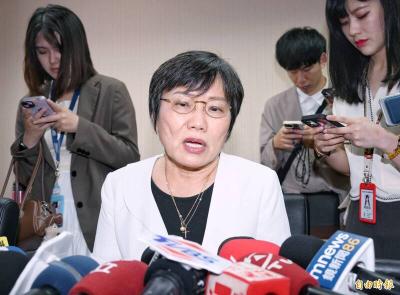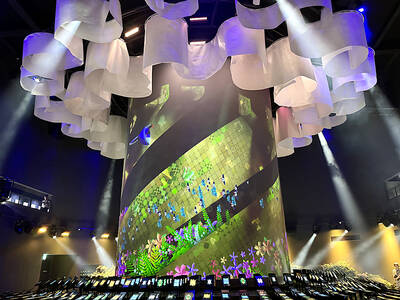Seven civic groups yesterday accused Taipei police of being “out of control” and resorting to “violent means” to evict antinuclear protesters who occupied Zhongxiao W Road on Sunday to stage an overnight sit-in.
The groups, including the National Nuclear Abolition Action Platform, the Taiwan Association for Human Rights and the Taipei Society, leveled the accusations at a morning press conference held in front of the Presidential Office Building.
The protesters occupied the often congested section of Zhongxiao W Road in front of Taipei Railway Station on Sunday afternoon in a bid to force the government to respond positively to their demands that the construction of the Fourth Nuclear Power Plant in New Taipei City’s Gongliao District (貢寮) be immediately halted and the voting threshold for national referendums lowered.
Acting on Taipei Mayor Hau Lung-bin’s (郝龍斌) orders, riot police fired water cannons at the crowd of activists to disperse them at 2:47am on Monday, before starting to forcibly push and drag protesters away.
Normal traffic flow on the road was restored about 6:50am.
One of the protesters evicted that night, a man surnamed Shen (沈), said that he had been standing in the front line of the crowd when police officers pushed him to the ground and ripped his gauze face mask off.
“Several officers dragged me by my ankles into a corner and then one of them said: ‘This one hit a police officer,’ and they all started beating me with their batons and shields,” Shen said, adding he heard officers shouting: “Let’s beat the hell out of him.”
He was handcuffed and denied his right to counsel even though he had put his hands up and told the officers he would not resist, Shen said.
“After I was detained for six hours, the police told me they had no idea who had arrested me and that they were unable to find any video footage confirming my account of the attack,” Shen said.
Lin Hsiu-yi (林秀怡), secretary-general of the Awakening Foundation, said she was astonished to see some officers trying to use a water cannon to remove a female protester’s pants.
“They even fired water at the rest of the crowd to prevent other protesters from seeing what they were doing to this woman,” Lin said.
Taipei Society head Liu Ching-yi (劉靜怡) questioned the police’s move to dispatch SWAT team officers to remove press photographers and reporters from a pedestrian overpass.
“What law did the reporters break by standing on the footbridge? The only logical explanation is that the police were trying to impede them from documenting the event,” Liu said.
Chang Shu-hui (張淑惠), head of the Association of Parent Participating Education in Taiwan, which mobilized 10 couples and their 12 children to participate in the occupation, accused the police of putting the children’s lives in danger.
“The police marched threateningly toward us and our children even after forcing us to retreat to the sidewalk... We demand that Mayor Hau apologize and take responsibility for the officers’ reprehensible behavior,” Chang said.
Taiwan Association for Human Rights deputy director Tseng Wei-kai (曾威凱) said the eviction was “an act of sheer abuse,” adding that the protesters were vastly outnumbered by police and hit by water cannons at close range.
“The police handled the situation flippantly and treated it as a chance to exact vengeance. They were out of control,” Tseng said. “The nation has lost its sanity.”
National Nuclear Abolition Action Platform spokesperson Tsuei Su-hsin (崔愫欣) said the group has received photographs and video footage from 78 people allegedly showing protesters being mistreated by police officers.
“We have also been approached by 23 protesters allegedly beaten by police, four photographers who say they were prevented from recording the rally and five women alleging either verbal or physical harassment from police officers,” Tsuei said.

Chinese Nationalist Party (KMT) Chairman Eric Chu (朱立倫), spokeswoman Yang Chih-yu (楊智伃) and Legislator Hsieh Lung-chieh (謝龍介) would be summoned by police for questioning for leading an illegal assembly on Thursday evening last week, Minister of the Interior Liu Shyh-fang (劉世芳) said today. The three KMT officials led an assembly outside the Taipei City Prosecutors’ Office, a restricted area where public assembly is not allowed, protesting the questioning of several KMT staff and searches of KMT headquarters and offices in a recall petition forgery case. Chu, Yang and Hsieh are all suspected of contravening the Assembly and Parade Act (集會遊行法) by holding

PRAISE: Japanese visitor Takashi Kubota said the Taiwanese temple architecture images showcased in the AI Art Gallery were the most impressive displays he saw Taiwan does not have an official pavilion at the World Expo in Osaka, Japan, because of its diplomatic predicament, but the government-backed Tech World pavilion is drawing interest with its unique recreations of works by Taiwanese artists. The pavilion features an artificial intelligence (AI)-based art gallery showcasing works of famous Taiwanese artists from the Japanese colonial period using innovative technologies. Among its main simulated displays are Eastern gouache paintings by Chen Chin (陳進), Lin Yu-shan (林玉山) and Kuo Hsueh-hu (郭雪湖), who were the three young Taiwanese painters selected for the East Asian Painting exhibition in 1927. Gouache is a water-based

Taiwan would welcome the return of Honduras as a diplomatic ally if its next president decides to make such a move, Minister of Foreign Affairs Lin Chia-lung (林佳龍) said yesterday. “Of course, we would welcome Honduras if they want to restore diplomatic ties with Taiwan after their elections,” Lin said at a meeting of the legislature’s Foreign Affairs and National Defense Committee, when asked to comment on statements made by two of the three Honduran presidential candidates during the presidential campaign in the Central American country. Taiwan is paying close attention to the region as a whole in the wake of a

OFF-TARGET: More than 30,000 participants were expected to take part in the Games next month, but only 6,550 foreign and 19,400 Taiwanese athletes have registered Taipei city councilors yesterday blasted the organizers of next month’s World Masters Games over sudden timetable and venue changes, which they said have caused thousands of participants to back out of the international sporting event, among other organizational issues. They also cited visa delays and political interference by China as reasons many foreign athletes are requesting refunds for the event, to be held from May 17 to 30. Jointly organized by the Taipei and New Taipei City governments, the games have been rocked by numerous controversies since preparations began in 2020. Taipei City Councilor Lin Yen-feng (林延鳳) said yesterday that new measures by